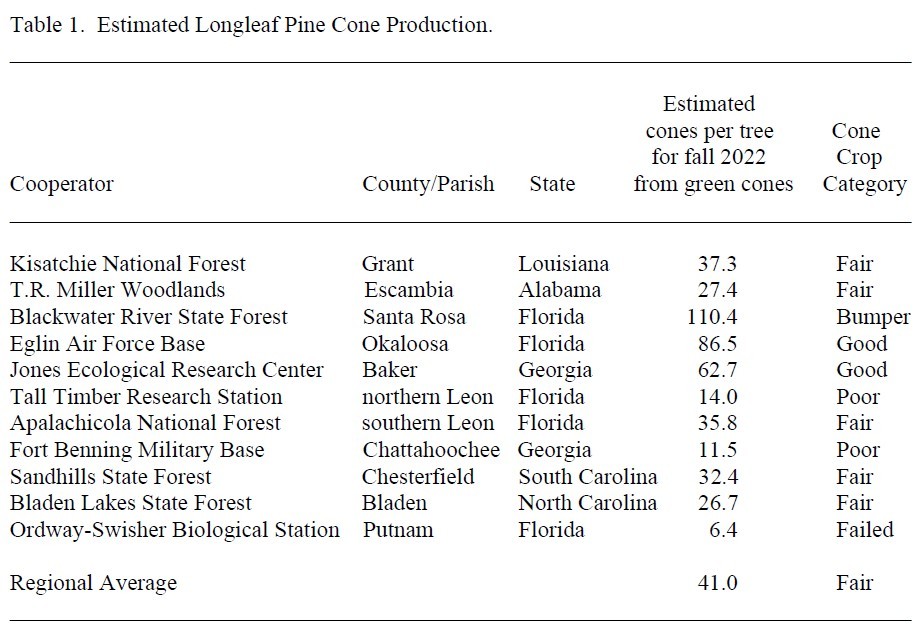Longleaf Pine Cone Prospects for 2022
June 27, 2022
Unlike some other southern yellow pine species, longleaf pine cone production is variable with infrequent good crops. The process is influenced by many environmental factors over the course of the cones' two-year development, with large differences observed from year to year and also from place to place.
Having an idea of upcoming cone crops helps longleaf growers plan for nursery seedling production and informs land managers' upcoming activities to promote natural regeneration, like prescribed burning or selective harvesting. The United States Forest Service and collaborators monitor longleaf pine cone production at 11 locations throughout the Southeast.
2022 Longleaf Cone Production
The regional cone crop, based on green cone counts, is fair for 2022, at 41.0 cones per tree. The natural variation, typically seen across the native range of longleaf pine, is apparent in this year’s data, with one site having a bumper crop, two sites good crops, five sites fair crops, two sites poor crops, and one site a failed crop.
A bumper crop (>100 cones per tree) is present in Santa Rosa County, Florida.
A good crop (50 to 99 cones per tree) is present in Baker County, Georgia and Okaloosa County, Florida.
A fair crop (25 to 49 cones per tree) is present in Grant Parish, Louisiana, Escambia County, Alabama, southern Leon County, Florida, Chesterfield County, South Carolina, and Bladen County, North Carolina.
A poor crop (10 to 24 cones per tree) is present in Chattahoochee County, Georgia and northern Leon County, Florida.
A failed crop (<10 cones per tree) is present in Putnum County, Florida.

The natural variation of longleaf pine cone production means that even when crops are forecast to be low, some stands may produce an abundance of cones. The best way to know the status on cone production for your particular property is to visually estimate cone production yourself. Instructions and a data collection sheet can be found in the 2022 Cone Prospects Report.
Longleaf Pine Seed Production & Germination
+ From strobili to pollination to fertilization to viable seed, the seeds contained in this year's longleaf pine cones have been over 2 years in the making.
+ Longleaf seed is larger and heavier than other southern pines. It does not disperse far from the parent tree.
+ Longleaf pine cones release seed in the fall, and the seed will germinate just a couple weeks after falling to the ground. You’ll often see new germinants with the seed/wing still attached.
+ Longleaf germinants will SURIVIVE and THRIVE where they can put down roots directly in soil. Seeds that germinate on top of litter or duff will likely die when the layer dries out if the young seedlings’ roots have not yet found good soil.
+ Late spring or early summer prescribed fires may be best to prepare for longleaf seed fall in October/November. The goal is to increase the likelihood that seed falls on bare mineral soil but not so clean that predators can find and destroy most of the new seed.






